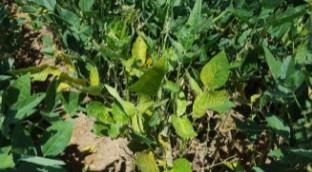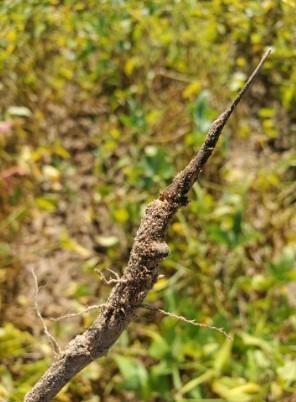By Ryan McGeeney
Farmers: Know thine enemy.

HARD TO MISS, EASY TO MISDIAGNOSE — Taproot decline is a syndrome long misdiagnosed by growers, consultants and even extension agents in Arkansas soybean fields and elsewhere. In 2020, however, researchers managed to finally identify the pathogen that causes the disease, bringing producers much closer to effectively diagnosing and treating the disease. (Image courtesy Terry Spurlock.)
For decades, Arkansas growers, and the consultants and extension agents who support their efforts, have combatted various soilborne diseases that either hobble or outright destroy crops.
Some diseases, along with the pathogens that cause them, are harder to pin down than others, making them prime candidates for misdiagnosis and a shotgun-style approach to control.
Taproot decline is a prime example in soybean. The disease, which can lead to yield losses estimated to be as much as 25 percent, was first detected in Arkansas about 15 years ago — but was often misdiagnosed as sudden death syndrome, stem canker, black root rot or another malady.
After initial detection of the disease around 2007 in southeast Arkansas, Mississippi and northeast Louisiana, it was subsequently identified in Alabama, Tennessee and Missouri. However, the cause eluded scientists until last year. In 2020, researchers established a causal relationship between taproot decline and the fungus Xylaria necrophora.
Discovering an unknown
Terry Spurlock, extension plant pathologist for the University of Arkansas System Division of Agriculture, said that part of the reason it took so long to establish that relationship was that the fungus itself was an unknown.

ROOT OF THE PROBLEM — A soybean root badly damaged by taproot decline. (Image courtesy Terry Spurlock.)
“The fungus wasn’t in any of the literature, because it was newly discovered” Spurlock said. “It wasn’t in any of the genetic profiles. We had to name it, and the new-to-us disease.
“That’s part of why taproot decline often gets misdiagnosed as other diseases,” he said. “It’s the newest doppelganger.”
For the past several years, Spurlock and other extension personnel have set out to equip consultants and cooperative extension agents with the knowledge to help growers start addressing the disease more effectively.
“We’re trying to get the growers and consultants up to speed, explaining that it’s different than these other diseases we’ve known about for many years, like sudden death syndrome or others,” Spurlock said.
While Spurlock is an extension plant pathologist for the Cooperative Extension Service, his research into taproot decline and other diseases is done as part of his appointment to the Arkansas Agricultural Experiment Station, the research arm of the Division of Agriculture.
An exceptional year
Spurlock said that the extreme flooding in the state, on top of already higher-than-average rainfall, has provided a rich platform on which plant pathogens can operate.
“There’s no such thing as a ‘normal year’ in Arkansas,” Spurlock said. “But this year, and especially in southeast Arkansas, we dealt with some tremendous flooding — I think that’s increased the pest pressure above what it has been in some other areas.
“There was significantly more seedling disease on soybean and cotton,” he said. “Those diseases are caused by fungi such as Rhizoctonia solani and organisms we manage as fungi, such as Pythium and Phytophthora spp. The soil system is a complicated environment and pathogens can significantly impact plant health when it is cool and wet.”
Far and wide
Once pathologists put a cause to the effect of taproot decline and began “connecting the dots” of previous reported symptoms from growers and consultants, they realized that Xylaria necrophora had a broader distribution than they had initially believed.
“It’s very widespread in certain parts of the Delta,” Spurlock said, “In Desha and Chicot counties, for instance, I know consultants that tell me they see a little disease in every field they check. Most of these folks are checking at least a few thousand acres of soybeans in a season.”
Arkansas growers typically plant about 3 million acres of soybean each year.
Taking up arms
Each year, Spurlock and other plant pathologists from the Division of Agriculture meet with their counterparts from Mississippi, and Louisiana, working together on variety testing, fungicide seed treatments, tillage methods and more to develop better ways of combatting the pests common to agricultural production in the region. Taproot decline is just the latest foe in an ongoing war.
“We’ve found some seed treatments that were more effective than others, but they haven’t been great,” Spurlock said. “Some fungicides applied in-furrow are more effective, but that’s very burdensome for most growers to do, and many aren’t set up to apply in-furrow fungicide at planting.
“We just don’t have great variety data to work with yet — it’s a hard disease to work with in a variety test,” he said. “It’s very sporadic — you get a patch here, a patch there. Sometimes you get a few sick plants; sometimes you get a patch big enough to park your truck in. You do a lot of these variety tests on research stations or on farmers’ fields, and it’s difficult to get enough disease throughout your test field to get a good evaluation.”
Spurlock said that thus far, the most effective method of managing the taproot decline fungus is also among the oldest: Simple rotation of crops.
“We know that soybeans in a field, if planted season after season after season, tend to produce the worst taproot decline,” Spurlock said. “So rotating to corn or rice — just getting away from soybean — helps. That’s been our top recommendation, in combination with a couple of different seed treatment fungicides.”
The same fight, but different
Spurlock said that while taproot decline may represent a new — or at least newly-assessed — disease in crops, there hasn’t been a major sea change in pest pressure over the last several decades. There’s always something.
“We have shifts in what the predominant disease is year to year, or maybe in a five-year stretch,” Spurlock said. “When I first started in this position, frogeye leaf spot was the predominant foliar disease issue on soybean in the Delta.
“We didn’t have high-yielding varieties that were resistant to that particular disease,” he said. “So, we didn’t plant those, we had to spray a lot of fungicides, and we managed the disease that way. Now it’s rare to find a field with a lot of frogeye, because plant breeding has done such a good job producing soybean varieties that are high-yielding and have frog-eye leafspot resistance.”
Spurlock said the development of high-yielding soybean, corn and other crops that are resistant to pests — including plant pathogenic fungi and nematodes — as well as tolerant of herbicides, have done more to increase yield and reduce input costs than any other modern effort.
“When we’ve had issues, we’ve bred to combat those issues,” he said. “Growers have adopted a lot of those varieties, either by choice, or because that’s just what’s been available. Those are some of the reasons for the shifts we see.”
Spurlock said plant breeding programs from the University of Arkansas System Division of Agriculture and other institutions have helped to combat other notorious pests as well.
“You could say the same thing for southern root-knot nematode,” he said. “For years, we didn’t have resistance; or at least, we didn’t have high-yielding soybean varieties in the maturity groups farmers preferred to grow in our area, that were also moderately resistant to southern root-knot nematodes, and now we do. There are also choices of different herbicide traits, offering our growers some flexibility. We’ll probably always struggle with southern root-knot nematode, but we’re making progress because of successful plant breeding.”
Source : uada.edu